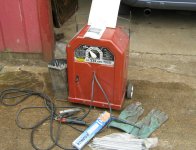Berniep
Platinum Member
I think that the plug on your welder is rated for more amps than the outlet in the first picture, Or maybe it's the other way around. Anyway A lot of people have that model welder wired up to the outlet in the first picture with no problems. Tractor supply has the outlets in your pictures and I am going this afternoon and I will see what they are rated for. I wired my welders to the one in the first picture but mine only pull 30 amps. You can pull 50 or 60 amps with that lincoln if you turn it all the way up.
although the one we had on the farm rarely got turned up past 150 output amps. Here is a page I found that lists the specs http://content.lincolnelectric.com/pdfs/products/literature/e230.pdf
although the one we had on the farm rarely got turned up past 150 output amps. Here is a page I found that lists the specs http://content.lincolnelectric.com/pdfs/products/literature/e230.pdf


